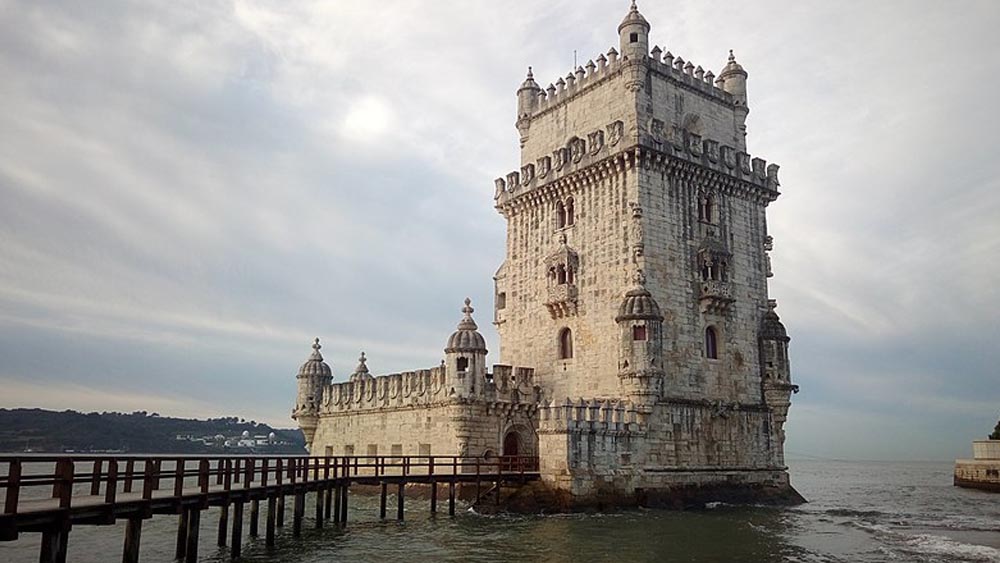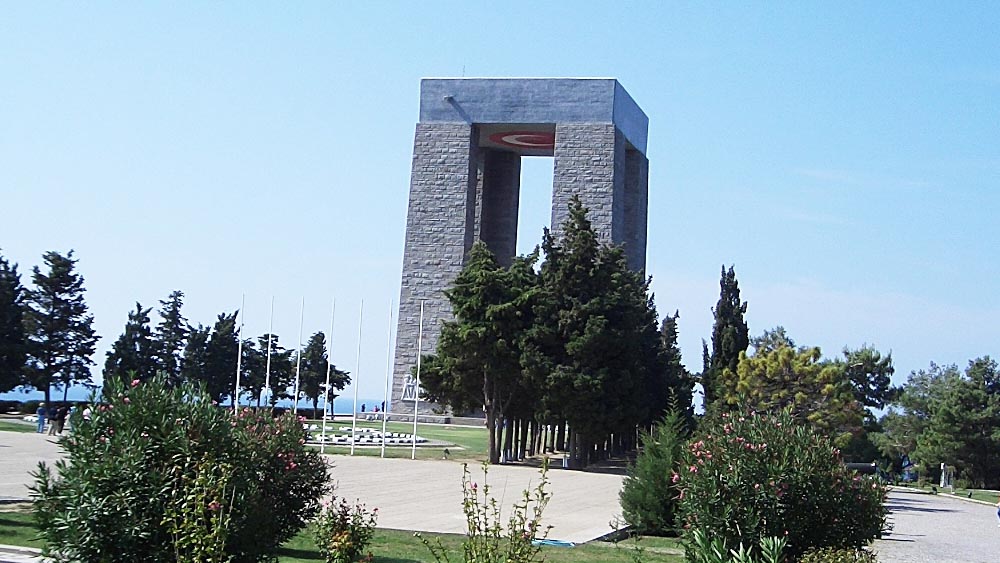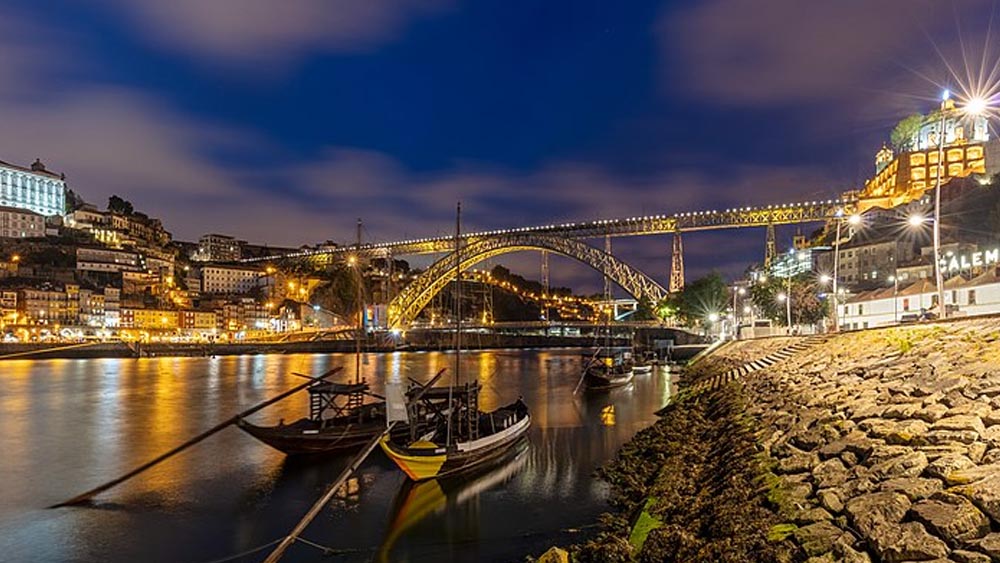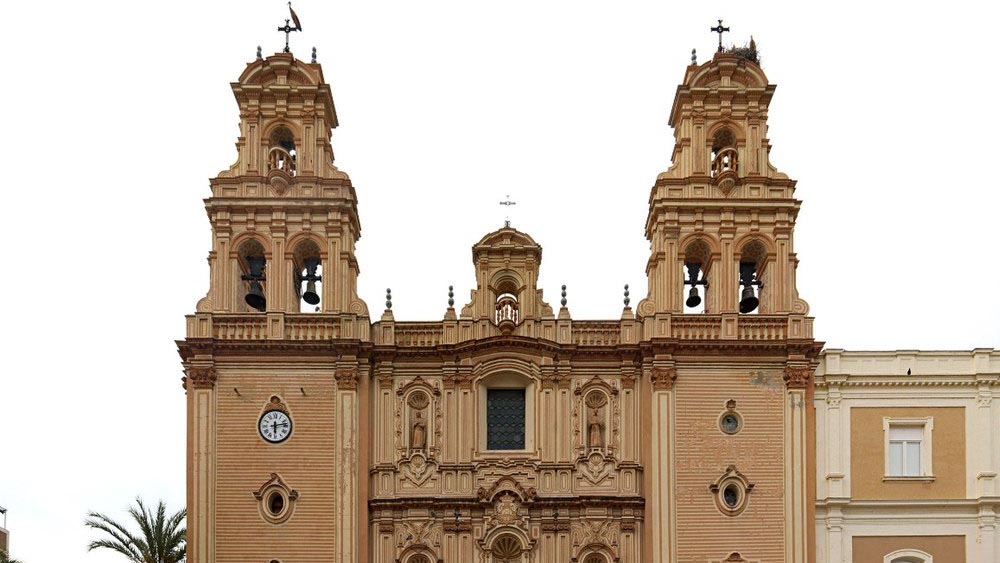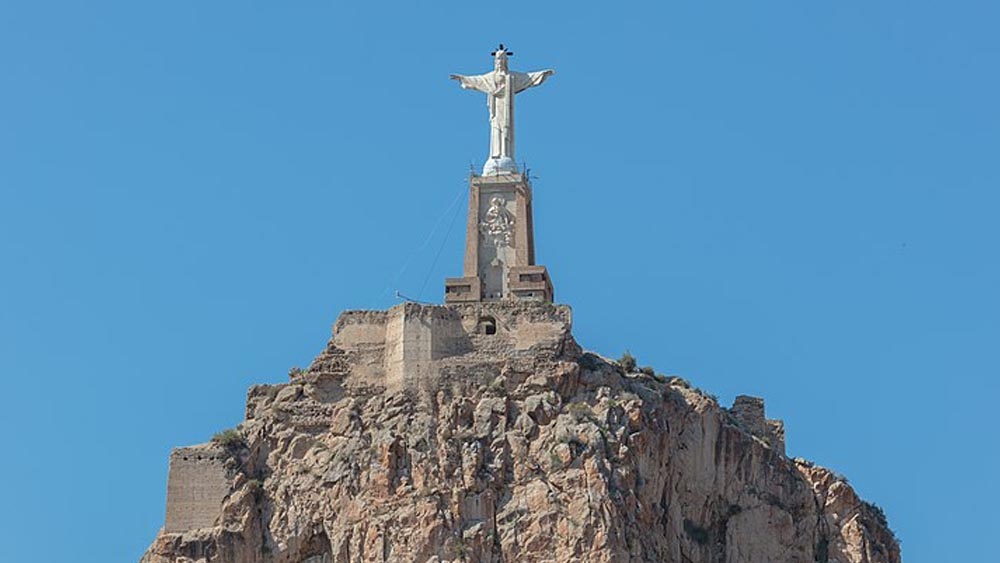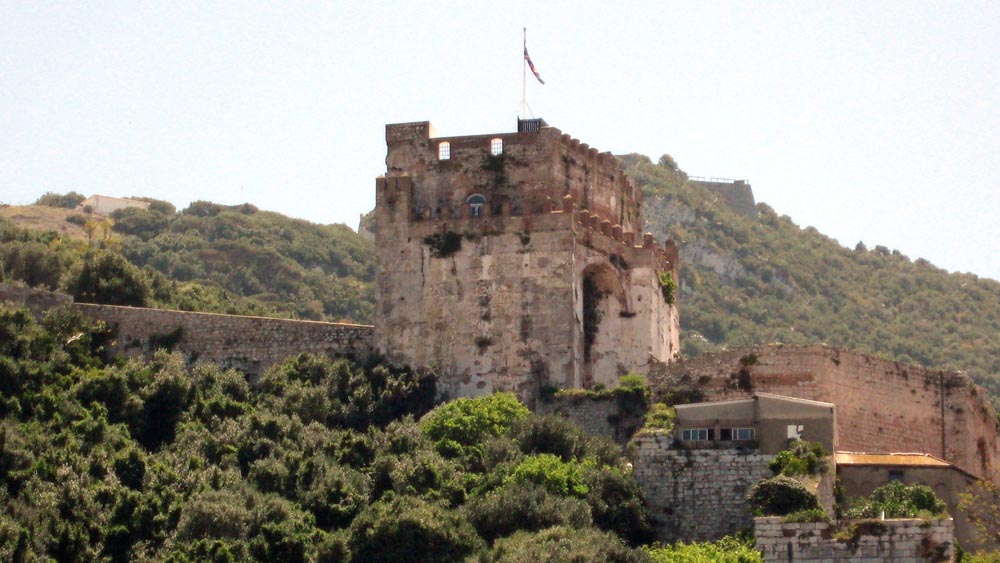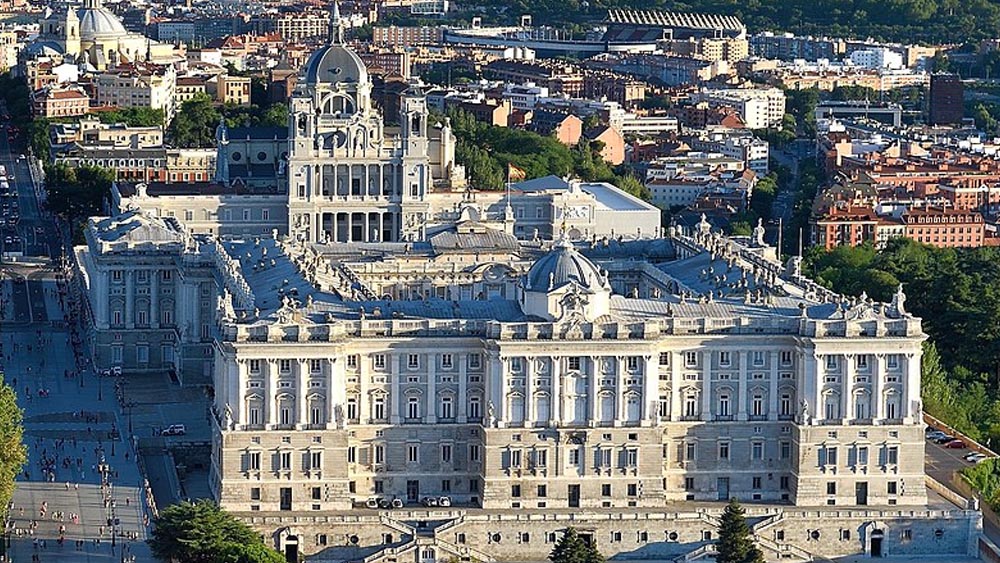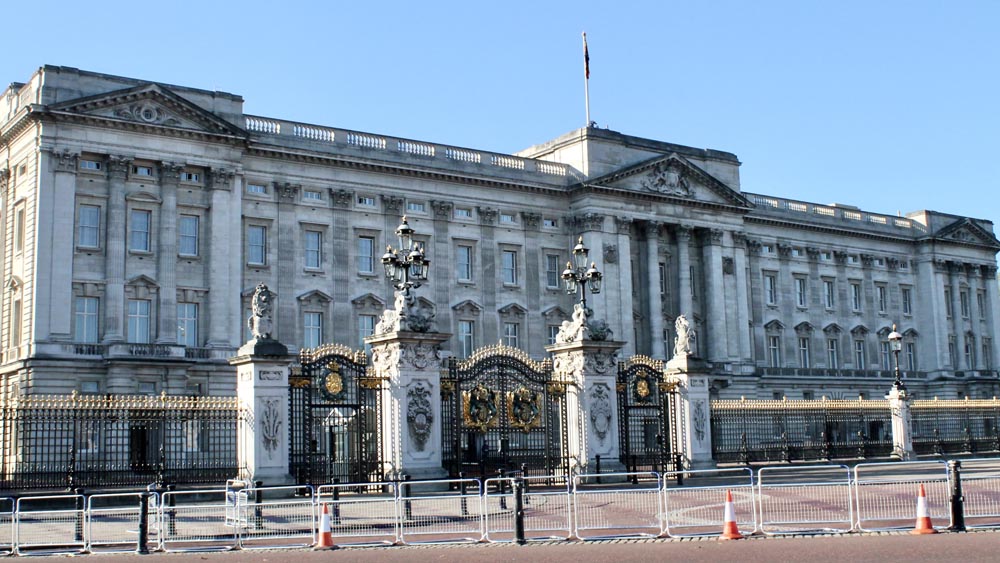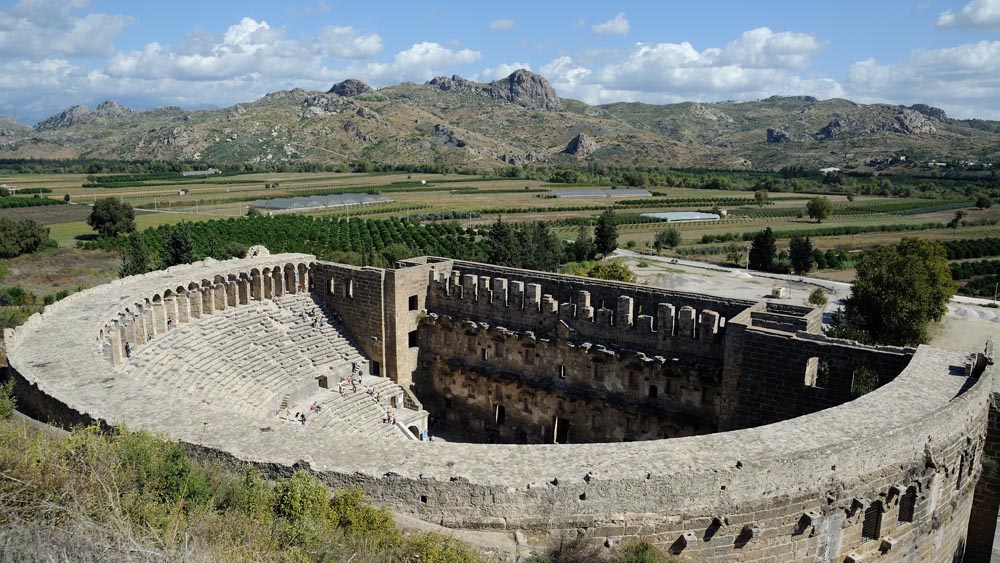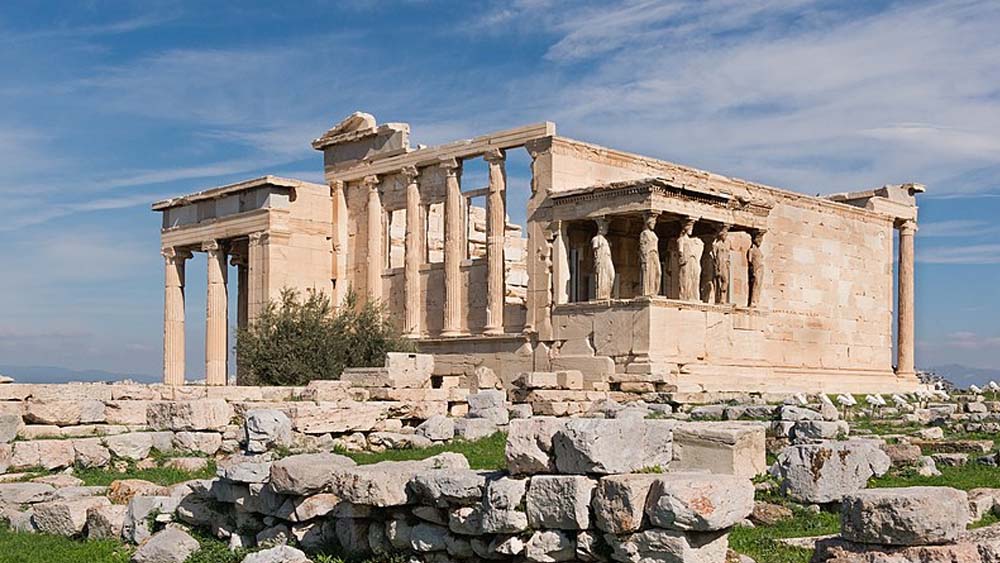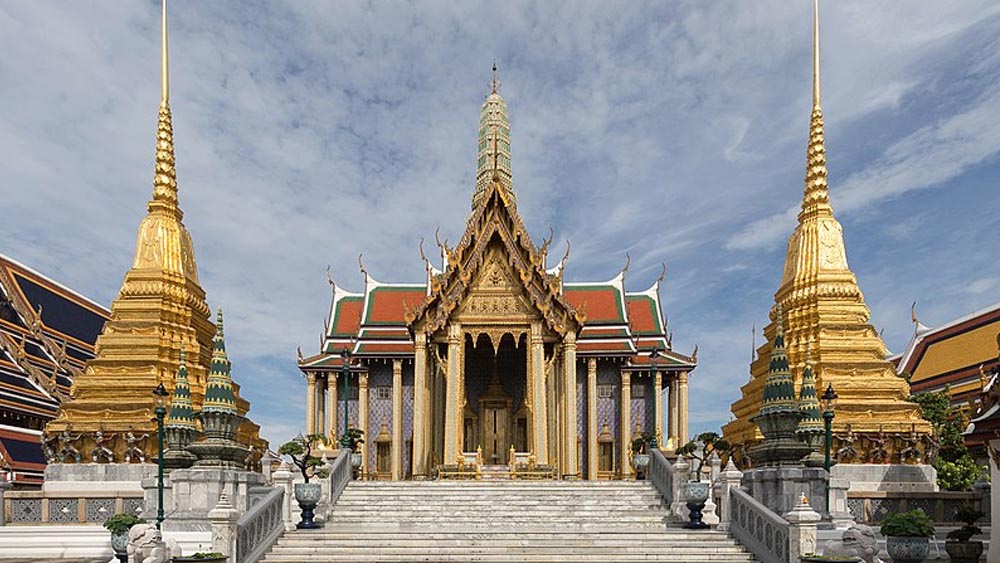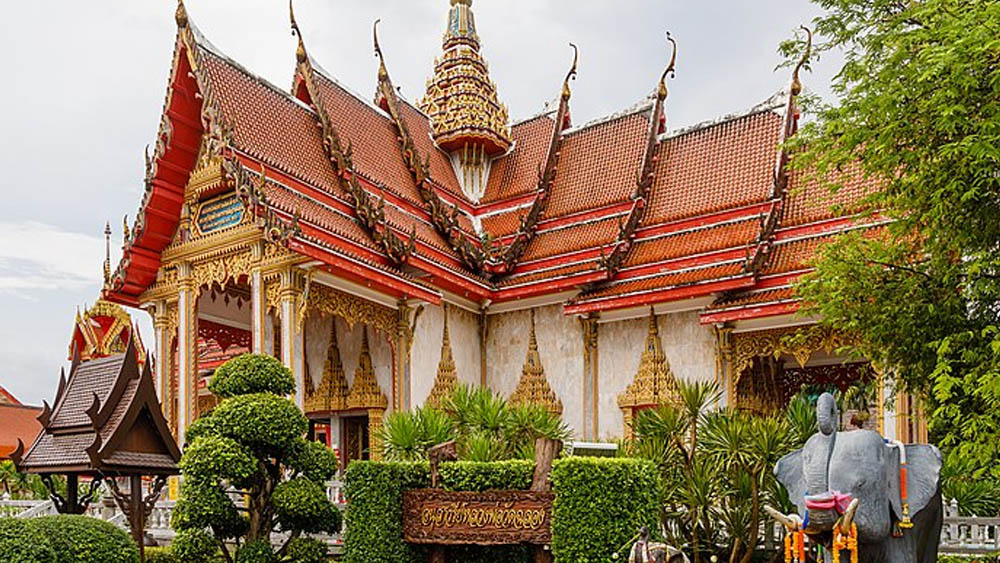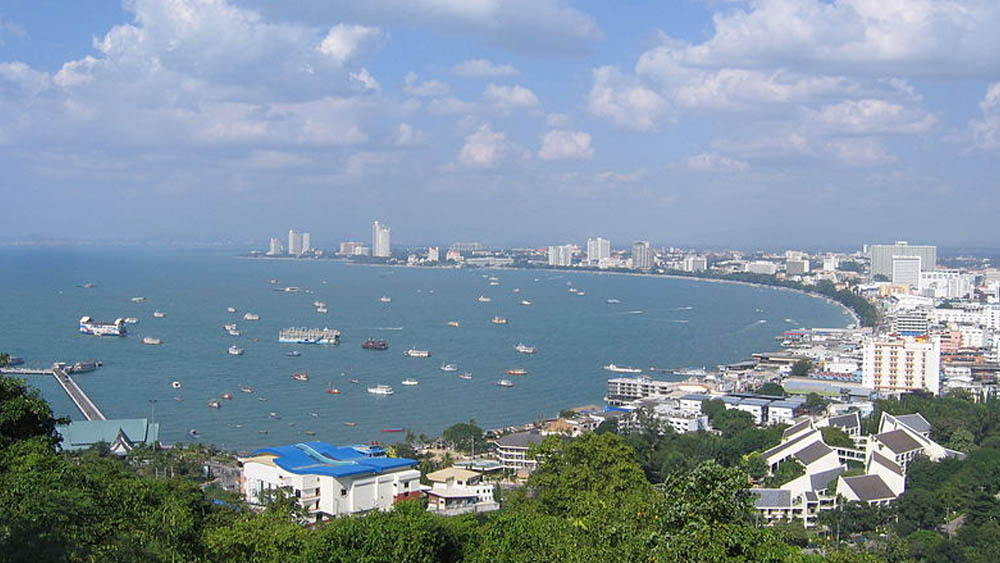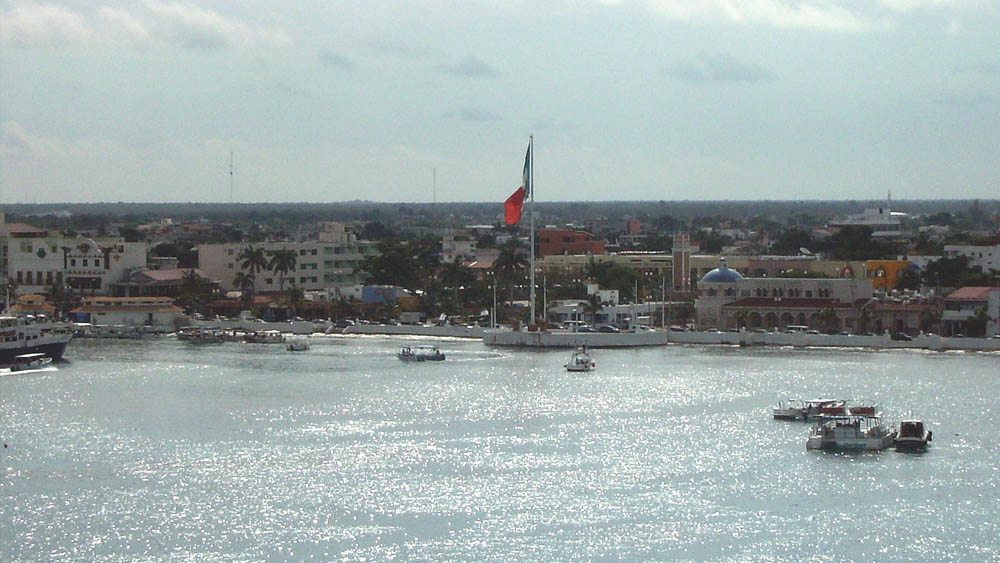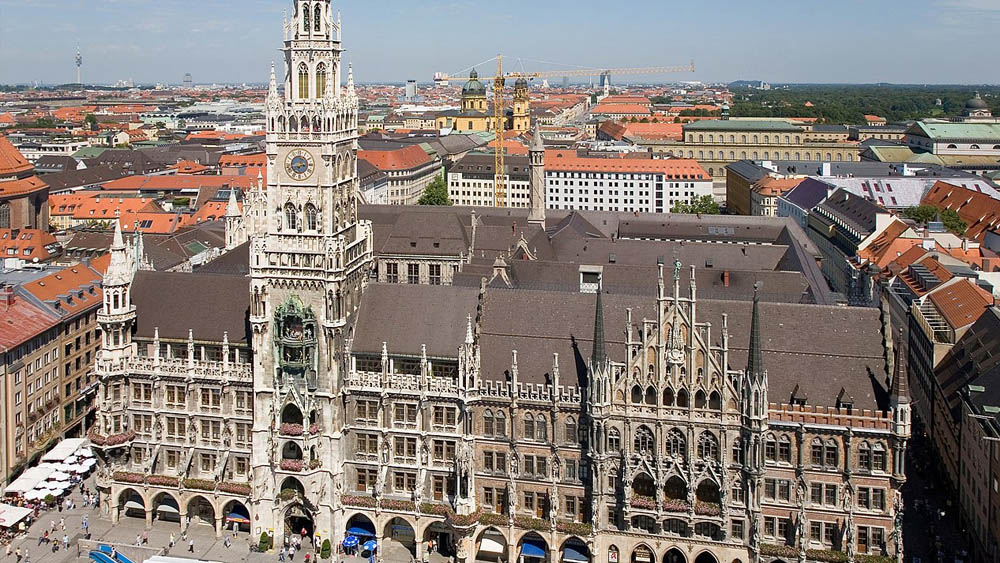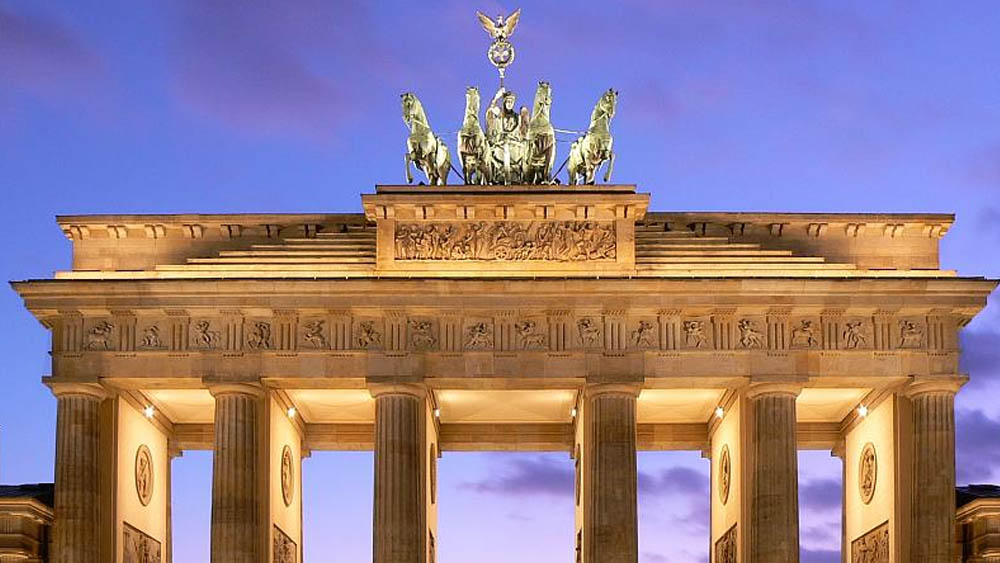Seville is one of Spain’s beautiful and historic cities, offering visitors a unique experience with its thousands of years of history. This enchanting city is renowned for its stunning architecture, impressive works of art, and vibrant cultural atmosphere.
Seville is home to many iconic structures that have gained worldwide fame, including the Alcazar Palace, the Giralda Tower, and the Seville Cathedral. It is also known for its narrow labyrinth-like streets, being the birthplace of traditional Flamenco dance, and its delicious tapas.
Moreover, the pleasant parks, gardens, and romantic walks along the river provide visitors with peaceful moments. Every trip to Seville is a unique opportunity to explore its rich cultural heritage and create unforgettable memories in a warm and friendly atmosphere.
Seville Cathedral: A Historical Journey with Spain’s Largest Cathedral

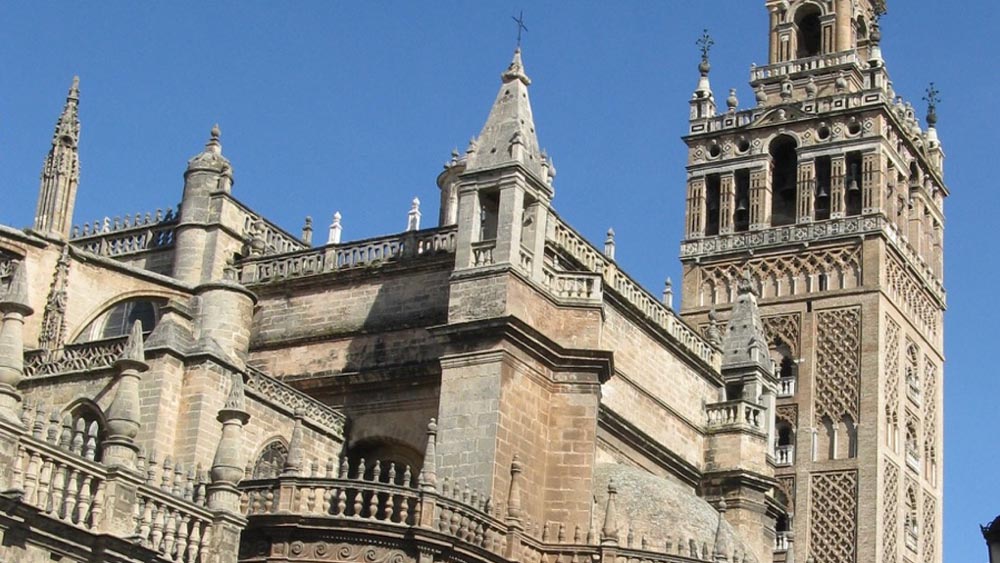
Seville Cathedral is a religious structure located in Seville, Spain, and it is the largest cathedral in Spain. This historic cathedral is an impressive example of Gothic and Renaissance styles and is a popular tourist destination. Here are some important points to know about Seville Cathedral:
- History: Construction of Seville Cathedral began in the 15th century and was completed in the 16th century. This site, which was once a mosque during the Islamic period of Al-Andalus, still retains some remnants from that era. The cathedral has become a symbol reflecting the historical and religious significance of Seville.
- Location: Seville Cathedral is situated in the center of Seville, in the Plaza de Santa Maria de la Sede. Its central location provides easy access to visit the cathedral and is also close to other tourist attractions in the surrounding area.
- Architecture: Seville Cathedral boasts a magnificent structure and incorporates several notable architectural features. The main entrance of the cathedral is the monumental Golden Door in the Gothic style. Inside, there are high vaulted naves, elegant columns, and intricate stained glass windows that create an impressive atmosphere.
- La Giralda: One of the most recognizable features of Seville Cathedral is the bell tower known as La Giralda. This tower was converted from an old minaret and completes the silhouette of the cathedral. By climbing La Giralda, visitors have the opportunity to enjoy breathtaking views of Seville.
- Tomb of Christopher Columbus: Inside Seville Cathedral, you will find the tomb of the famous explorer Christopher Columbus. The tomb is located in a chapel within the cathedral’s interior and serves as a remarkable monument.
- Artworks Inside: Seville Cathedral houses many important artworks. Among them is the Great Altarpiece, located in the Main Chapel, which is considered one of the largest religious paintings in the world. Additionally, the cathedral’s collection of precious sacred objects and religious art is also noteworthy.
Seville Cathedral is one of Spain’s largest and most impressive cathedrals. Its historical and architectural beauty captivates visitors, making it a must-see destination for anyone exploring Seville.
Real Alcázar: Witness the Splendor of the Historic Palace in Seville
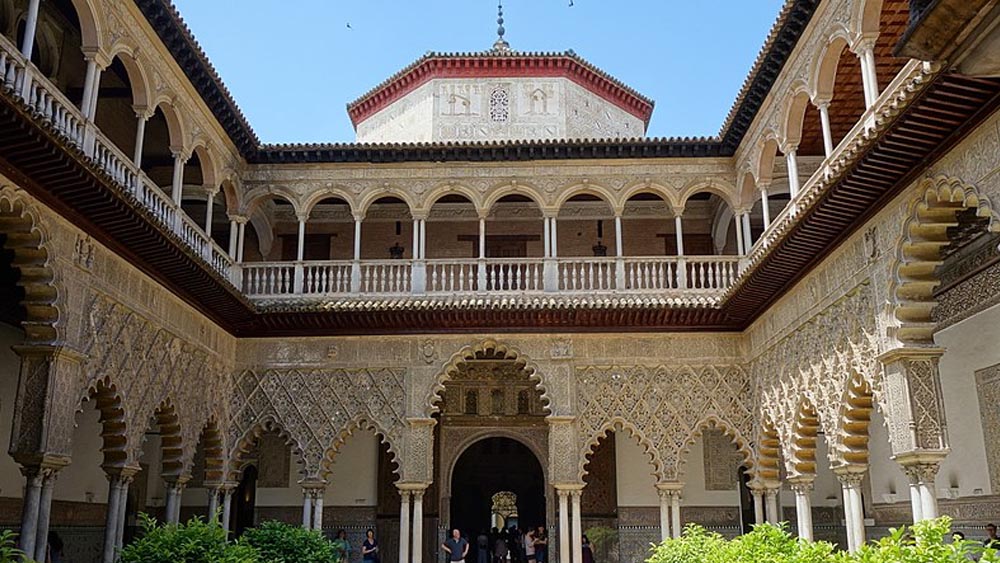
Real Alcázar is a historic palace complex located in Seville, Spain, and it is listed as a UNESCO World Heritage site. This magnificent structure reflects an impressive blend of Andalusian Islamic, Gothic, and Renaissance styles. Real Alcázar offers visitors an unforgettable experience with its enchanting gardens, elegant architecture, and rich history. Here are some important points to know about Real Alcázar:
- History: Real Alcázar was initially built by Islamic rulers in the 10th century and was later expanded and modified by Christian monarchs. As a result, the palace showcases both Andalusian Islamic and Christian influences. This combination makes Real Alcázar unique and fascinating.
- Architecture: The architecture of Real Alcázar presents a captivating aesthetic. The sections constructed with Islamic influence feature intricate geometric patterns, columns, and arches. The areas from the Renaissance period exhibit more symmetrical and ornate details. The frescoes, carvings, and decorations inside the palace’s interior also provide a mesmerizing visual feast.
- Gardens: The gardens of Real Alcázar serve as a captivating escape for visitors. As you walk through the gardens, you’ll encounter fountains, pools, exotic plants, and breathtaking landscapes. Different sections of the gardens are designed in various styles, including the Spanish Garden, the Don Juan Carlos Garden, and the English Garden.
- Sala de los Embajadores: One of the most impressive rooms in Real Alcázar is the Sala de los Embajadores, known as the Hall of Ambassadors. This hall is adorned with a stunning golden dome and features rich embellishments. The surrounding walls also display Islamic decorations and mosaics.
- Los Baños de Doña Maria de Padilla: The underground water reservoirs known as Los Baños offer a refreshing atmosphere in Real Alcázar. This section showcases columned galleries with Gothic architecture and pools of water. Among these pools, the most famous one is the Doña Maria de Padilla pool, which creates a mesmerizing reflection.
Real Alcázar is one of the most important historical sites to visit in Seville. Its splendid architecture, stunning gardens, and rich history enchant visitors and provide a genuine journey through time.
Plaza de España: Enjoy a Stroll in Seville’s Iconic Square
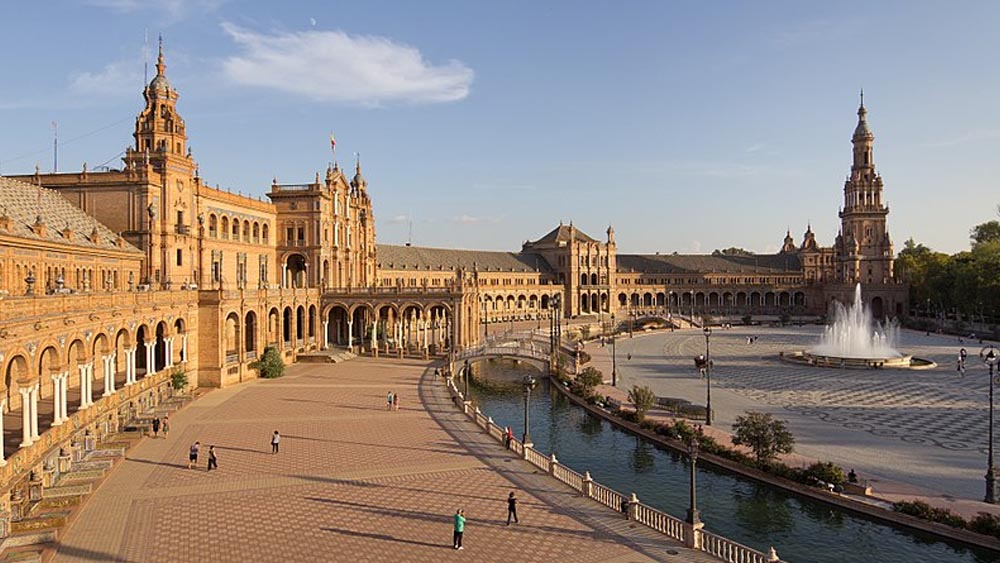
Plaza de España is one of the most famous and iconic squares in Seville, Spain. This magnificent square was built for the 1929 Ibero-American Exposition and showcases an impressive combination of Andalusian Islamic, Renaissance, and Neo-Mudéjar styles. Plaza de España offers visitors an unforgettable experience with its elegant architecture, colorful ceramic-decorated canals, and expansive courtyard. Here are some important points you should know about Plaza de España:
- Architecture: The architecture of Plaza de España presents a captivating view. The square has a semi-circular structure surrounded by a two-story gallery. In front of the gallery, there is a canal that can be accessed through bridges. The walls and bridges of the square are adorned with colorful ceramics and covered with mosaics representing symbols of various regions.
- Courtyard: Plaza de España has a spacious courtyard that serves as a gathering point for locals and tourists. In the center of the courtyard, there is a fountain surrounded by benches. While strolling in the courtyard, you can enjoy beautiful views and closely examine the architectural details of the square.
- Canals and Bridges: The canals surrounding Plaza de España are a significant feature of the square. You can take boat rides in these canals and reach different areas of the square by crossing the bridges. The paths around the canals are ideal for a pleasant walk.
- Mosaics and Symbols: The ceramic-covered walls and bridges of Plaza de España are adorned with various symbols and mosaics. These symbols represent coats of arms and figures representing different regions of Spain. The colorful and intricate designs of the mosaics contribute to the enchanting atmosphere of the square.
- Film Location: Plaza de España is a popular location used in many films and television productions. It was especially used to represent the planet of Naboo in the “Star Wars: The Clone Wars” series. While exploring the square, you may recall film scenes and feel like you are inside a movie.
Plaza de España is one of the most impressive and beautiful squares in Seville. With its historical and architectural beauties, vibrant atmosphere, and unique design, it offers visitors an unforgettable experience.
Giralda Tower: A Magnificent Observation Point and the Symbol of Seville
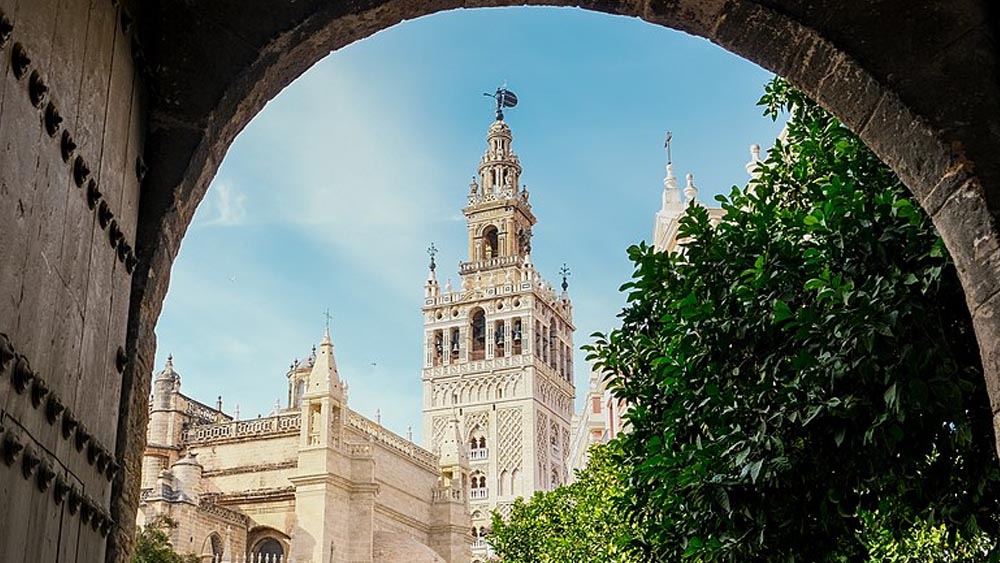
Giralda Tower is a historic tower located in Seville, Spain, and is one of the city’s most famous symbols. This impressive structure was originally built as the minaret of the Seville Cathedral and is easily recognizable in the city’s skyline. Giralda offers a fascinating experience both historically and visually as an observation point. Here are some important points you should know about Giralda Tower:
- History: Giralda Tower was built in the 12th century during the Andalusian Islamic period. Originally used as a minaret, the tower was converted into a bell tower with the construction of the Seville Cathedral. Therefore, Giralda is an important structure that reflects both Islamic and Christian heritage.
- Architecture: Giralda Tower features unique architecture. Its lower part reflects the intricate geometric patterns and arches of the Andalusian Islamic style. The upper part, built in a simpler manner, belongs to the Christian period. The tower stands at approximately 104 meters in height and is one of the highest points in Seville.
- Ramps: Ramps are used to access Giralda, providing visitors with easy accessibility. Instead of stairs, ramps are used to ascend the tower, making it easier for disabled visitors and those using wheelchairs to access.
- Panoramic Views: One of the most enchanting aspects of Giralda Tower is its breathtaking panoramic views of the city. When you climb the tower, you can enjoy a bird’s-eye view of Seville’s historic center, the cathedral, Plaza de España, and its wide surroundings. Additionally, you can appreciate the natural beauty of the Guadalquivir River and the surrounding areas of Seville.
- Bells: Giralda Tower houses functioning bells. These bells are rung especially during religious ceremonies and special occasions. When you ascend the tower, you can hear the impressive sound of the bells and experience the historical atmosphere.
Giralda Tower is one of Seville’s most renowned and impressive symbols. With its history, architecture, and breathtaking views, it is a must-see for anyone visiting Seville.
Santa Cruz Neighborhood: Sevilla’s Historical Center with Narrow Streets and Enchanting Atmosphere


Santa Cruz Neighborhood is a captivating district located in the historic center of Seville. With its narrow streets, traditional Spanish houses, flower-filled courtyards, and historical charm, it offers visitors a unique atmosphere. Here are some important points you should know about the Santa Cruz Neighborhood:
- History: Santa Cruz Neighborhood is the former Jewish quarter of Seville. It was once home to the Spanish Jewish community, which made significant contributions to Spain’s historical and cultural heritage. The neighborhood gives visitors a sense of traveling back in time with its narrow streets and historical buildings.
- Narrow Streets: The Santa Cruz Neighborhood is famous for its labyrinthine narrow streets. These streets, adorned with whitewashed houses and flower-filled pots, can make you feel like getting lost as you wander through them. The narrow streets add a mystical ambiance to the neighborhood and provide an exciting environment for exploration.
- Plaza de Santa Cruz: Located in the heart of the neighborhood, Plaza de Santa Cruz is an ideal square to relax and savor the atmosphere. It features a beautiful fountain, benches, and cafes/restaurants. By sitting in the square, you can observe the surrounding historical buildings and streets.
- Casa de Pilatos: Casa de Pilatos, located in the Santa Cruz Neighborhood, is an important historical structure built in the 16th century. This palace reflects an impressive blend of Spanish and Mudéjar styles, with its stunning courtyard, ornate gardens, and artistically valuable interiors. By visiting Casa de Pilatos, you can explore the rich historical and cultural past of Seville.
- Tapas Bars and Restaurants: The Santa Cruz Neighborhood is known for housing some of Seville’s best tapas bars and restaurants. Here, you can try local delicacies, indulge in wine tastings, and savor the delights of Spanish cuisine. While strolling through the streets of the neighborhood, you can discover ideal places to sample local flavors.
Santa Cruz Neighborhood is one of the most important areas to visit in Seville. With its historical fabric, narrow streets, and enchanting atmosphere, it offers visitors an unforgettable experience. As you explore the neighborhood, you can closely feel Seville’s traditional and vibrant culture.
Triana Neighborhood: Seville’s Colorful District Filled with Flamenco, Ceramics, and Local Culture

Triana Neighborhood is one of the colorful and traditional districts of Seville. It is famous for flamenco music, ceramic art, and local culture. Here are some important points you should know about the Triana Neighborhood:
- Flamenco: Triana is considered one of the origins of flamenco music and dance in Spain. The neighborhood is a hub where many famous flamenco artists have been raised, and it is home to important flamenco venues. By visiting Triana, you can watch vibrant flamenco performances and enjoy the passion of this music and dance.
- Ceramic Art: Triana is one of the centers of the famous ceramic art in Seville. The neighborhood is renowned for its traditional ceramic workshops and shops. Triana ceramics stand out with their colorful patterns and craftsmanship. While exploring the neighborhood, you can visit ceramic workshops and discover Triana’s ceramic heritage.
- Local Markets: Triana Neighborhood is also famous for its lively markets. Mercado de Triana is a popular market where fresh fruits, vegetables, seafood, and other local products are sold. By strolling through the market, you can taste local delicacies and witness the local life of the neighborhood.
- Bridges: Triana is known for its bridges that connect the neighborhood to other parts of Seville across the Guadalquivir River. Triana Bridge (Puente de Isabel II) is one of the main entry points to the neighborhood and boasts an impressive appearance. When you cross the bridge and step into the Triana Neighborhood, you can feel its unique atmosphere.
- Tapas Bars and Restaurants: Triana is a neighborhood that houses some of the best tapas bars and restaurants in Seville. Here, you can try local flavors and indulge in the taste of traditional Spanish cuisine. The neighborhood has a vibrant dining culture, and you can explore local tastes by hopping from one tapas bar to another.
Triana Neighborhood is an ideal spot to explore Seville’s local culture, flamenco music, and ceramic art. By wandering through its colorful streets, markets, bridges, and local establishments, you can discover the vibrant atmosphere of the neighborhood. When visiting Seville, be sure to allocate time to experience the lively ambiance of the Triana Neighborhood.
María Luisa Park: Relax in the Largest and Most Beautiful Park of Seville, Surrounded by Nature

María Luisa Park, one of the largest and most beautiful parks in Seville, is known for its vast green areas, colorful flowers, and historical architecture, offering visitors the opportunity to relax and enjoy their time in the midst of nature. Here are some important points to know about María Luisa Park:
- History: María Luisa Park was built as the main venue for the 1929 Ibero-American Exposition, known as Expo 29. The park is named after the Spanish Queen María Luisa and is located next to the former palace of the royal family in Seville. After the exposition, the park was opened to the public and has become a popular recreational area in Seville.
- Park Features: María Luisa Park stands out with its stunning landscaping and expansive green areas. At the center of the park, there is Plaza de España, an impressive structure surrounded by canals and an artificial lake. Additionally, the park is adorned with ponds, fountains, statues, palm trees, and flower-filled gardens. These features create a captivating atmosphere while walking or relaxing in the park.
- Plaza de España: One of the most remarkable spots in María Luisa Park is Plaza de España. This large semicircular structure is adorned with ceramic mosaics representing different regions. Surrounded by canals and bridges, it offers visitors a pleasant walk and an opportunity for taking photos. Plaza de España is known as one of the symbols of Seville.
- Activities: María Luisa Park is an ideal place for nature enthusiasts. You can go for a walk, ride a bicycle, or have a picnic in the park. Additionally, you can sit on the benches, relax, or rent a rowboat to take a leisurely ride on the lake. The tranquil atmosphere of the park provides visitors with a close connection to nature.
- Museums and Gardens: Within María Luisa Park, there are museums and gardens located in various areas of the park. For instance, the Archaeological Museum is a popular culture and history museum that exhibits historical artifacts. Furthermore, the San Telmo Palace and the Museum of Popular Arts and Traditions, located in the Plaza de América, are other places worth visiting.
María Luisa Park showcases a glimpse of Seville’s natural beauty and historical charm. Taking a walk, immersing oneself in nature, and finding tranquility in this enchanting park is an excellent choice. When visiting Seville, make sure to allocate time to enjoy the peaceful atmosphere of María Luisa Park.
Archivo General de Indias: A Journey into the Past at the Important Archive in Seville, Following the Footsteps of Discoveries
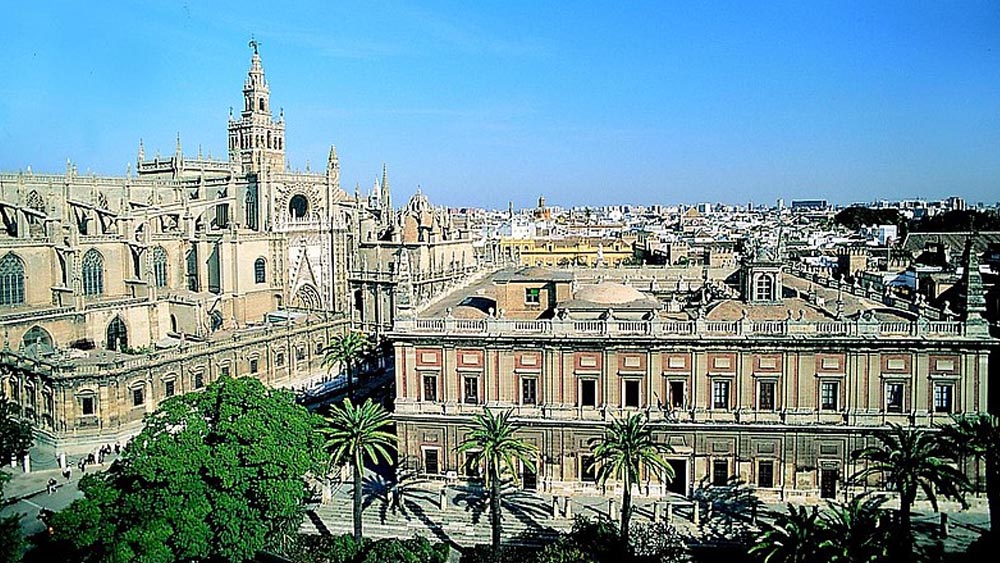
The Archivo General de Indias is an important archive located in Seville, Spain, and it is a significant place for those who want to trace the traces of discoveries and embark on a journey into the past. The archive houses documents related to Spain’s colonies in the Americas and offers a rich source of information on historical events such as discoveries, the colonial period, and the exploration of the Americas. Here are some important points to know about the Archivo General de Indias:
- History: The Archivo General de Indias was established in 1785 and was initially built to preserve documents related to the administration and governance of Spanish America. The archive is also an important structure that contributes to the historical fabric of Seville.
- Collection: The archive hosts an extensive collection, including over 80 million documents and more than 9,000 maps. These documents contain information about discoveries in the Americas, the colonial era, colonization, trade, and other historical events. The documents in the archive hold great significance for researchers, historians, and interested individuals.
- Building and Architecture: The Archivo General de Indias is housed in an impressive building located near the Plaza de España. The architecture of the building reflects the historical and cultural essence of Seville, with notable influences of Plateresque and Neo-Renaissance styles. The interior of the building stands out with stunning ceiling craftsmanship and decorations.
- Visitor Experience: The Archivo General de Indias offers visitors the opportunity to explore the archive’s collection and historical importance. Visitors can access temporary and permanent exhibitions that display the documents in the archive. Additionally, special permissions can be granted to access the documents for research purposes. Examining the documents in the archive and witnessing historical details provides an exciting experience of journeying into the past.
The Archivo General de Indias stands out as an essential stop for those interested in history and wanting to trace the footsteps of discoveries. By visiting this archive, you can gain a better understanding of Spain’s historical influence in the Americas and how discoveries have impacted the world.
Plaza de Toros de la Maestranza: A Cultural Experience in the Famous Bullfighting Arena

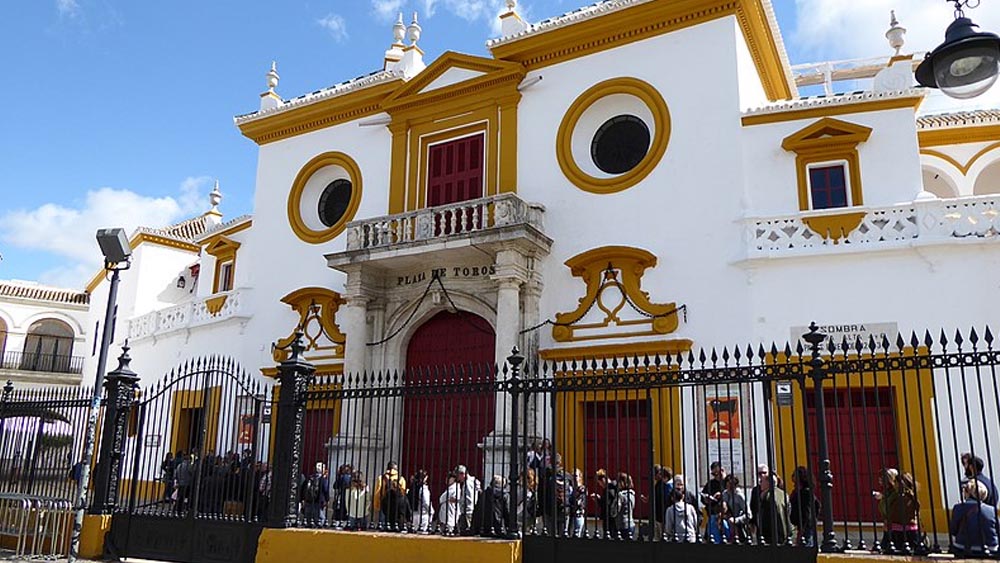
Plaza de Toros de la Maestranza is the famous bullfighting arena in Seville and an important place for those seeking a cultural experience. Bullfighting is regarded as a part of the local tradition in Spain, and Plaza de Toros de la Maestranza is considered the center of this traditional sport. The arena provides a historical and impressive atmosphere and is used for bullfighting events and performances. Here are some important points to know about Plaza de Toros de la Maestranza:
- History: Plaza de Toros de la Maestranza was built in the 18th century and is one of the oldest bullfighting arenas in Spain. The construction of the arena coincided with the period when bullfighting gained popularity. Today, this historical structure still hosts bullfighting events.
- Architecture: Plaza de Toros de la Maestranza boasts impressive architecture. The exterior of the arena is designed in the Spanish Baroque style and has a stunning appearance. Inside, the seating encircles the bullfighting area in the center, allowing the audience to focus on the spectacle. The historical atmosphere of the arena adds a distinct touch to bullfighting events.
- Bullfighting Events: Plaza de Toros de la Maestranza is used for bullfighting events and performances. Bullfighting is a sport that holds deep cultural significance in Spain. In the events held at the arena, matadors face bulls and perform various displays. Attending bullfighting events provides an opportunity to get a closer look at Spanish culture and traditions.
- Museum: Plaza de Toros de la Maestranza also houses a museum dedicated to bullfighting. The museum features exhibitions that depict the history, traditions, and important figures of bullfighting. This museum offers visitors a chance to learn more about bullfighting and explore the cultural heritage of the arena.
Plaza de Toros de la Maestranza is an important destination for those who wish to experience bullfighting culture and history. However, bullfighting events can be a controversial topic, and it is important to make a personal evaluation before participating in such events.
Flamenco Show: Witness a Passionate and Captivating Dance Performance in Seville

Seville is one of the most famous flamenco centers in Spain, and watching a passionate and mesmerizing flamenco show here is an unforgettable experience. Flamenco is a traditional art form that combines Spanish music, dance, and emotion. In Seville, there are several options to experience flamenco culture and witness this passionate dance performance.
- Flamenco Show Venues: Seville has many flamenco show venues where professional flamenco dancers and musicians perform. The shows are usually accompanied by live music and create an impressive atmosphere with the dancers’ energetic movements and emotional performances. Venues in neighborhoods like El Arenal, Triana, and Santa Cruz are ideal options for popular flamenco shows in Seville.
- Flamenco Biennial: Seville hosts the Flamenco Biennial, which is held every two years and is one of the most important events of flamenco art. The Biennial brings together international flamenco artists and groups in Seville for a festival. During the Biennial, flamenco shows, concerts, workshops, and exhibitions take place in various venues across the city. The Biennial period is an ideal time to experience the pulse of flamenco art in Seville.
- Flamenco Schools: Seville is home to many flamenco schools where you can learn and experience flamenco art. These schools offer opportunities to learn flamenco dance and music with professional instructors. Flamenco schools are often open to tourists and visitors, and some offer short-term courses or trial classes. This way, you can get a closer experience of flamenco art and discover your own talents.
Watching a flamenco show in Seville is a great opportunity to feel the deep connection of this passionate and emotional dance to its origins and Spanish culture. A flamenco show filled with the energy of passionate dancers and musicians will be an unforgettable part of your time spent in Seville.
Explore Casa de Pilatos: A Unique Palace Combining Renaissance and Mudéjar Styles

Casa de Pilatos is a unique palace located in Seville that combines Renaissance and Mudéjar styles. This historic structure was built by the wealthy Spanish family, the Medinaceli Dukes. Here are some important points to know about Casa de Pilatos:
- Architecture: Casa de Pilatos boasts an impressive architecture that reflects a unique blend of Renaissance and Mudéjar styles. The exterior of the palace is adorned with ornate windows, embossed decorations, and elegant details. The interior features courtyards, gardens, ornate ceilings, and marble embellishments. These architectural features complete the grand atmosphere of the palace.
- Courtyards: One of the most striking features of Casa de Pilatos is its courtyards. There are two different courtyards, the inner courtyard and the outer courtyard. The inner courtyard is designed in the Mudéjar style, adorned with columns, arches, and fountains. The outer courtyard, on the other hand, follows the Renaissance style and is surrounded by sculptures, marble details, and gardens. The courtyards create a peaceful and impressive atmosphere at the heart of the palace.
- Artworks: Casa de Pilatos hosts many significant artworks. Paintings, frescoes, and historical portraits hanging on the walls form the palace’s rich art collection. Additionally, decorative artworks such as furniture, ceramics, and sculptures are worth seeing.
- Gardens: The palace’s gardens offer a tranquil and green escape. You can take a stroll in the gardens, discover various plant species, and admire the water features like the adorned fountains. The gardens provide visitors with a relaxing atmosphere and the opportunity to explore the surroundings of the palace.
Casa de Pilatos is an important historical site that should be visited in Seville. The palace’s unique architecture, artworks, and gardens allow visitors to experience the richness of Renaissance and Mudéjar styles and get a glimpse of Spanish palace life.
Metropol Parasol: Observe the Panorama of the City with Seville’s Modern and Majestic Structure

Metropol Parasol is one of the modern and impressive structures in Seville, and it is an ideal spot to observe the panoramic view of the city. Also known as “Setas de Sevilla” (Seville’s Mushrooms), here are some key points about this structure:
- Architecture: Metropol Parasol is one of the world’s largest wooden structures. The building consists of a series of wooden structures that resemble a massive mushroom. The wooden lattice has a modern design that stands out in the city’s skyline. Metropol Parasol is located in La Encarnación Square in the Alameda de Hércules area.
- Viewing Point: Metropol Parasol features an observation point that offers visitors a magnificent panoramic view. The terrace on the top floor of the structure provides a panoramic view of Seville’s historic center, the Giralda Tower, the Seville Cathedral, and other significant landmarks. From here, you can observe the overall structure of the city, its streets, and surrounding squares.
- Ancient Roman Ruins: During the construction of Metropol Parasol, important remains from the Roman period were discovered. These ruins are exhibited in an archaeological area called the “Meeting Point of Ancient Rome” located underneath the structure. In this area, you can see mosaics, columns, and other remnants from the Roman era.
- Activities: Underneath Metropol Parasol, visitors can enjoy various activity options such as restaurants, cafes, and shops. You can relax and have a drink in the spaces inside the structure or shop for souvenirs. Additionally, events, concerts, and exhibitions are occasionally held here.
Metropol Parasol, a modern and impressive symbol of Seville, is an important place to visit in the city. The unique architecture of the structure, the viewing point, and the various activities provide visitors with an opportunity to discover the beauty of Seville and enjoy its panoramic view.
Plaza de San Francisco: Relax in Seville’s Historic Square and Feel the Atmosphere of the City


Plaza de San Francisco is one of the historic squares in Seville and an ideal spot to soak in the atmosphere of the city and relax. This square is located near the Seville Cathedral and holds historical and cultural significance. Here are some important points to know about Plaza de San Francisco:
- Historical Importance: Plaza de San Francisco is one of the oldest squares in Seville with a rich history. The San Francisco Church, located here, was built in the 13th century, and there are many other historical buildings and structures around the square. The historical ambiance of the square offers visitors an opportunity to take a journey into the past.
- Cafes and Restaurants: Plaza de San Francisco is a lively area with many cafes and restaurants in its vicinity. You can sit around the square and enjoy a drink or taste the famous tapas of Seville. This square is a popular meeting point for locals and tourists alike.
- Statues and Monuments: Several statues and monuments can be found in Plaza de San Francisco. One of them is a monument dedicated to El Cid, an important historical figure in Seville. The other statues and monuments in the square reflect the historical and cultural heritage of Seville.
- Nearby Points of Interest: Plaza de San Francisco is also close to other significant tourist attractions in Seville. Historical and architecturally important sites such as the Seville Cathedral, the Giralda Tower, and the Alcázar Palace are within a short distance from the square. Therefore, after relaxing in the square, it serves as an ideal starting point to explore the surrounding areas.
Plaza de San Francisco is an excellent square in Seville to breathe in the city’s atmosphere, relax, and have a pleasant time. Its historical ambiance, cafes and restaurants, and nearby points of interest provide visitors with an opportunity to discover the liveliness and cultural richness of Seville.
Seville Museum: An Important Museum in Seville Filled with the Richness of Art and Culture

Seville Museum (Museo de Bellas Artes de Sevilla) is an important museum in Seville that is filled with the richness of art and culture. The museum was established to exhibit fine art and preserve Seville’s artistic heritage. Here are some important points to know about the Seville Museum:
- History and Building: The Seville Museum is located in the former Santa María de las Cuevas Monastery, an old monastery built in the 17th century. This monastery is known for being the burial place of Christopher Columbus at one point. The museum was founded in 1839 and opened to the public in 1841.
- Art Collection: The Seville Museum houses significant artworks, especially from the Renaissance and Baroque periods. The collection includes works by renowned painters of the Seville School, such as Francisco de Zurbarán, Bartolomé Esteban Murillo, and Diego Velázquez. Additionally, there is a Flamenco section that features costumes and photographs of Antonio Ruiz Soler, an important figure in Flamenco dance.
- Temporary Exhibitions: The Seville Museum regularly hosts temporary exhibitions. These exhibitions may focus on different periods, art movements, or artists. The temporary exhibitions bring a different perspective and experience to the museum, adding to its overall richness.
- Garden and Courtyard: The museum’s garden and courtyard provide visitors with a beautiful space to relax and observe their surroundings. The trees, plants, and fountains in the garden create an ideal environment for spending tranquil moments.
The Seville Museum is an important stop for those who want to explore the richness of art and culture in the city. With its historical building, extensive art collection, and various temporary exhibitions, the museum offers visitors an unforgettable experience. By visiting the museum, you can witness Seville’s artistic and cultural heritage up close and discover its rich art treasures.
Torre del Oro: Explore Maritime History in Seville’s Historic Golden Tower
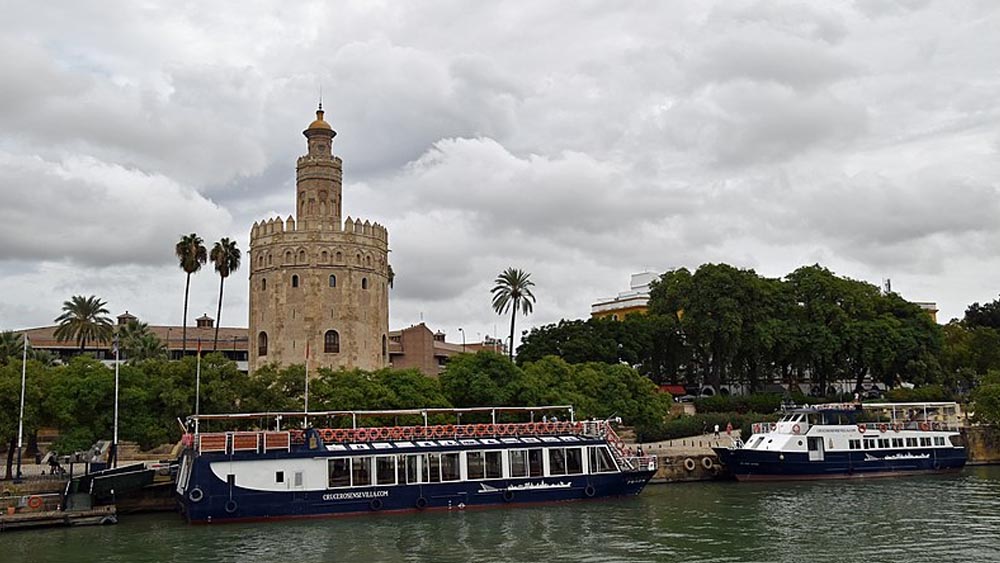
Torre del Oro (Golden Tower) is one of the historical symbols of Seville and an important point to explore maritime history. This tower is located on the banks of the Guadalquivir River and was built to protect the historical port of Seville. Here are some important points you should know about Torre del Oro:
- History and Name: Torre del Oro was built in the 13th century during the Islamic period. The tower was used to prevent attacks from the sea and protect the city. Its name comes from the golden tiles that give the tower its golden color.
- Architectural Features: Torre del Oro is a circular tower with three levels. The first two levels are adorned with arched windows that can be observed from the outside. The upper level has a simpler structure. The tower was built as part of Seville’s old city walls.
- Maritime Museum: Torre del Oro currently houses the Maritime Museum. The museum showcases the maritime history and the connection between Seville and the sea. Visitors can gain important insights into maritime history through exhibited items such as ship models, maritime tools, and maps.
- Panoramic Views: By climbing the tower, you can enjoy the panoramic view of Seville. From the top, you can see the Guadalquivir River, the Triana district, and other significant landmarks of the city. Climbing the tower, especially during sunset, offers an impressive scenery.
Torre del Oro is an ideal place to explore Seville’s maritime history and observe the city’s beautiful views. With its historical significance, impressive architecture, and the Maritime Museum, it provides visitors with an unforgettable experience. By visiting the tower, you can gain a closer understanding of Seville’s relationship with the sea and its maritime past.
Isabella Bridge: Enjoy the Scenic View on the Elegant Bridge over the Guadalquivir River

Isabe Bridge (Puente de Isabel II) is an elegant bridge located in Seville, spanning the Guadalquivir River. The bridge connects the historic center of Seville with the Triana district. Here are some important points to know about Isabe Bridge:
- History and Name: Isabe Bridge was constructed in the 19th century and is named after Queen Isabel II. The construction of the bridge was carried out to replace an old bridge over the Guadalquivir River.
- Elegant Design: Isabe Bridge is designed in the neoclassical style and has an elegant appearance. The bridge is open to both pedestrian and vehicular traffic and is supported by 13 arches. There are walkways and roadways beneath the arches. The bridge features neoclassical columns and statues on both sides.
- Connection with the Triana District: Isabe Bridge connects the historic center of Seville with the Triana district. Triana is a traditional neighborhood famous for flamenco and ceramics production. The bridge offers visitors the opportunity to explore the historic center and experience the vibrant atmosphere of the Triana district.
- River View: Since Isabe Bridge is located over the Guadalquivir River, it provides a magnificent view of the river. You can take a walk along the river, join boat tours, or simply enjoy the scenery. Particularly during sunset, you can indulge in the pleasure of admiring the view from the bridge.
Isabe Bridge is one of the important landmarks to visit in Seville. With its elegant design, connection to the Triana district, and river view, it offers visitors a delightful experience. By crossing the bridge, you can explore the historic center of Seville and immerse yourself in the colorful atmosphere of the Triana district. Additionally, you can spend a peaceful time enjoying the river view from the bridge.
La Macarena Neighborhood: A Vibrant Quarter in Seville Filled with Folklore and Religious Traditions


La Macarena Neighborhood is a vibrant quarter in Seville filled with folklore and religious traditions. This neighborhood is located north of Seville’s historic center and is particularly famous for its Semana Santa (Holy Week) celebrations. Here are some important points to know about La Macarena Neighborhood:
- Semana Santa Celebrations: La Macarena Neighborhood is one of the important places where Semana Santa celebrations take place in Seville. Semana Santa refers to the religious celebrations that occur before Easter and are celebrated with great enthusiasm throughout Spain. Impressive processions where religious figures are carried and religious rituals on the streets are held in La Macarena Neighborhood.
- The Virgin of Macarena: The neighborhood takes its name from the famous Virgin of Macarena. The Virgin of Macarena is one of the most important religious icons in Seville and is at the center of the Semana Santa celebrations. Every year, hundreds of thousands of people flock to the neighborhood to participate in the procession carrying the statue of the Virgin of Macarena.
- Lively Atmosphere: La Macarena Neighborhood has a captivating atmosphere with its colorful houses, narrow alleys, and balconies adorned with flowers. The temples, churches, and religious structures in the neighborhood also offer visitors a historical and religious experience.
- Folklore and Cultural Events: La Macarena Neighborhood is known as a hub for cultural events such as folk dances and music. Activities like flamenco performances, local festivals, and street performances create a vibrant cultural atmosphere in the neighborhood.
La Macarena Neighborhood is one of the neighborhoods in Seville where folklore and religious traditions are most intense. With its Semana Santa celebrations, the Virgin of Macarena, and lively atmosphere, it offers visitors an unforgettable experience. By exploring the neighborhood, you can get a close look at Seville’s folklore and religious heritage and participate in lively cultural events.
Santa Ana Church: A Unique Church in Seville Combining Gothic and Mudéjar Styles

The Santa Ana Church, located in Seville, is a unique church that combines Gothic and Mudéjar styles. This church is situated in the historic center of Seville and offers visitors both an architecturally interesting experience and a place of historical and religious importance. Here are some important points to know about the Santa Ana Church:
- Architectural Style: The Santa Ana Church reflects a combination of Gothic and Mudéjar styles. With its high arches, pointed-arch windows, and striking details, the church creates a captivating atmosphere in the Gothic style. It also carries influences from the Mudéjar style, which emerged as a result of the interaction between Islamic and Christian cultures in Spain.
- History: Construction of the Santa Ana Church began in the 13th century and continued until the 17th century. The church has made a significant contribution to the historical and religious heritage of Seville. The artworks found inside and around the church provide clues about the city’s past.
- Interior: The interior of the church is also remarkable. It features high ceilings, majestic columns, stained glass windows, and numerous chapels adorned with religious figures. While exploring the interior of the church, you can observe the combination of Gothic and Mudéjar styles and enjoy the historical atmosphere.
- Santa Ana Festival: The Santa Ana Festival, named after the church, is one of the most important festivals in Seville. This festival takes place around the church in July and is celebrated with various religious and cultural events. During the festival, street festivities, dance performances, and music shows are organized around the church.
The Santa Ana Church is an important church that should be visited in Seville. With its captivating architecture that blends Gothic and Mudéjar styles, you can experience the historical and religious atmosphere while exploring its interior. You can also participate in special events like the Santa Ana Festival. It is a significant stop for visitors who want to discover Seville’s rich cultural and religious heritage.
University of Seville: Where Culture and Science Meet in a Historic and Prestigious University

The University of Seville is a renowned higher education institution in Spain and worldwide, recognized for its historical significance and prestige. This university, where culture and science converge, stands out with its rich history and diverse academic opportunities. Here is some information about the University of Seville:
- History: The University of Seville was founded in the 16th century and is one of the oldest universities in Spain. The university is located in Seville, which had a great influence during the Spanish Golden Age and is adjacent to the Seville Cathedral and Alcázar.
- Historical Sites: The University of Seville is famous for its historical sites and impressive buildings. The university campus is situated in an area that was once the Royal Tobacco Factory, also known as Carmen. This palace is also known as the place where the renowned Spanish writer Cervantes wrote his Don Quixote.
- Academic Excellence: The University of Seville promotes academic excellence in various disciplines by offering a wide range of undergraduate and postgraduate programs. It has multiple faculties and departments for studying different fields such as humanities, social sciences, natural sciences, engineering, health sciences, and business.
- Cultural Activities: The University of Seville serves as a hub for students to engage in rich cultural activities. Various events such as theater performances, music concerts, art exhibitions, conferences, and workshops are organized. Students have the opportunity to enhance their cultural experiences and immerse themselves in Seville’s artistic atmosphere by participating in these events.
- International Collaborations: The University of Seville actively collaborates with international students and academics. It conducts joint research projects with many countries and participates in international student exchange programs. This provides an excellent opportunity for students who seek to receive education with a global perspective and explore different cultures.
The University of Seville offers an educational experience that combines cultural heritage and academic excellence. By visiting the university’s website, you can obtain more information and find detailed guidance on the application process.
Discover the Italica Archaeological Site: Explore an Ancient Roman City near Seville
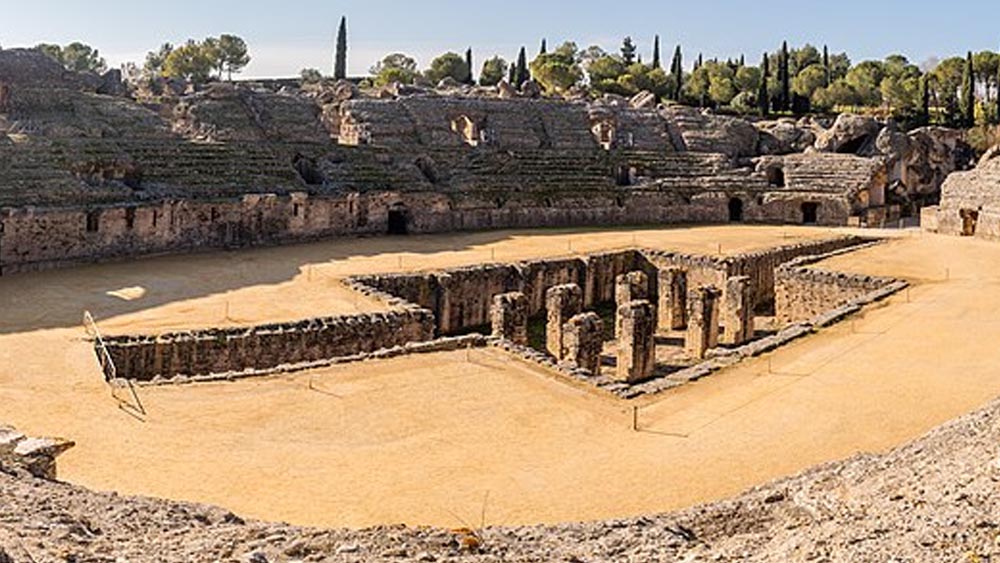
Italica, located near Sevilla, is an ancient Roman city and is currently preserved as an archaeological site. This ancient city is situated in the village of Santiponce, approximately 9 km away from Sevilla. Below are some important pieces of information to explore Italica:
- History and Significance: Italica was founded by the Romans in 206 BC and experienced significant development during the reign of Emperor Trajan. Known as the birthplace of Emperor Hadrian, Italica was a strategic and cultural center for the Romans. Additionally, this ancient city was home to one of the most important gladiator schools of the Roman Empire.
- Places to Visit: Italica offers several important areas to visit. These include an amphitheater, a theater, temples, baths, mosaic-adorned houses, and a forum. The amphitheater was one of the largest in the Roman Empire, with a seating capacity of approximately 25,000 spectators. The theater is a well-preserved example of a Roman-era theater, with its stage and seating areas. Moreover, the mosaics inside the houses reflect the artistic and decorative richness of the ancient period.
- Integration of Italy and Hispania: Italica symbolizes the integration of Italy and Hispania during the Roman Empire. Emerging from the combination of Italian and native Hispania populations, this ancient city possesses a rich cultural and social blend. This integration can be observed in the architecture and artistic works of Italica.
- Festivals and Events: Various events take place throughout the year in Italica. One of the most notable events is the Roman Games. These events feature gladiator fights, costumed performances, and other ancient games reminiscent of the Roman era. These events offer visitors the opportunity to experience ancient Roman culture.
The Italica Archaeological Site opens the doors to a historical treasure near Sevilla. For those interested in the ancient Roman period, this site serves as a fascinating point of visitation. If you wish to visit, you can obtain up-to-date information regarding opening hours and admission fees from the local tourism office or the official website.
Sevilla Districts: Tracing the Traces of Culture, Art, and Life in Different Neighborhoods of the City


Sevilla’s different neighborhoods offer a wonderful experience of tracing the city’s culture, art, and way of life. Here are some neighborhoods you can explore in Sevilla:
- Santa Cruz: Santa Cruz is one of the most famous neighborhoods in Sevilla. It is known for its narrow labyrinthine streets, flower-filled courtyards, and traditional Spanish houses. As you walk through this neighborhood, you can feel the typical Andalusian atmosphere and explore its historical and cultural richness due to its proximity to important tourist sites like Plaza de España and Sevilla Cathedral.
- Triana: Another vibrant neighborhood in Sevilla, Triana is known for its traditional Flamenco and bohemian atmosphere. Located across the Guadalquivir River, this neighborhood is home to the famous Triana Bridge. Triana is renowned for its ceramic workshops, narrow streets, tapas bars, and local flamenco performances. By exploring the neighborhood, you can visit Triana Market, San Jacinto Street, and Triana Church.
- Macarena: Macarena is a neighborhood filled with traditional Spanish quarters. The neighborhood is home to the famous Macarena Basilica, known for its statue of the Virgin de la Macarena, also known as the Mother of Jesus. Walking along the streets in this neighborhood allows you to trace the traces of local life and taste traditional tapas at local restaurants.
- Alameda de Hércules: Alameda de Hércules is one of Sevilla’s modern and hip neighborhoods, popular among young people and art enthusiasts. In this neighborhood, you can find street art, independent galleries, bookstores, cafes, and bars. While exploring Alameda de Hércules, you can experience the vibrant atmosphere of modern art and alternative culture.
- Arenal: Arenal is a neighborhood near the historic center of Sevilla and is home to important places such as Plaza de Toros de la Maestranza (Bullring) and Real Maestranza de Caballería (Equestrian School). The neighborhood also hosts numerous restaurants, bars, and boutique shops. By walking in the Arenal neighborhood, you can see beautiful architectural examples and immerse yourself in the lively atmosphere of the city.
These neighborhoods are excellent points to explore the possibilities filled with Sevilla’s culture, art, and way of life. Each neighborhood has its own unique atmosphere and charm, allowing you to experience the rich cultural fabric of Sevilla.
Antigua Tabacalera: Encounter Art and Culture in a Transformed Tobacco Factory in Sevilla

The old tobacco factory, known as Antigua Tabacalera, located in Seville, has been transformed into a space for art and cultural activities. This place serves as a center where creative endeavors are showcased, artists share their work, and cultural events are organized. Here is some information about Antigua Tabacalera:
- History: Antigua Tabacalera is a tobacco factory that was built in the 18th century. Originally used for tobacco processing and cigarette production, this historic building fell into disuse over time. However, it has been restored and converted into a venue for art and cultural activities.
- Art and Exhibitions: Antigua Tabacalera features an exhibition area where contemporary art is showcased. Paintings, sculptures, photographs, installations, and other artworks are regularly exhibited here. Additionally, interactive exhibitions and special events are organized, showcasing the works of local and international artists.
- Workshops and Educational Programs: Antigua Tabacalera offers workshops and educational programs to enhance artistic and cultural skills. Various workshops are conducted in fields such as painting, photography, dance, theater, crafts, and more. These workshops provide participants with opportunities to learn new skills and engage in creative processes.
- Concerts and Performances: Antigua Tabacalera hosts live music concerts, dance performances, theater plays, and other performing arts events. Local and international artists take the stage in this venue, providing visitors with unforgettable experiences.
- Community Center: Antigua Tabacalera also serves as a community center for the local population in Seville. Various community activities, seminars, conferences, and social projects are organized, bringing together the local community and fostering interaction. This enables the local residents to come together and engage in art and cultural activities.
Antigua Tabacalera is a dynamic space that brings together art and culture in Seville. By visiting, you can explore the works of local and international artists, participate in workshops, and experience live performances.
La Cartuja Island: Visit a Baroque-style Church and an Old Monastery in Seville

La Cartuja Island is a historical island located on the Guadalquivir River in Sevilla and is an important tourist destination in the region. The La Cartuja Monastery on this island is one of the baroque-style churches in Sevilla and offers visitors a historical and cultural experience. Here is some information about La Cartuja Island and the Monastery:
- History: The La Cartuja Monastery was established in the 15th century. The monastery was used until the expropriation of church properties with the Mendizabal Law in 1835. It was later restored in preparation for the 1992 World Expo.
- Baroque-style Church: The La Cartuja Monastery features a church built in the baroque style. Its interior is adorned with stunning frescoes and has rich decorations. The church hosts religious ceremonies as well as concerts and other cultural events.
- Outdoor Spaces: La Cartuja Island has impressive gardens and spacious outdoor areas. These spaces allow visitors to enjoy a pleasant walk, have a picnic, or simply admire the scenery. Additionally, some sculptures and artworks located on the island are worth seeing.
- Art and Culture: La Cartuja Island serves as a center for art and cultural events. Exhibitions, biennials, concerts, and other artistic activities take place inside and around the monastery. This provides visitors with an opportunity to experience current trends in the art world.
- Contents: The La Cartuja Monastery has become a complex that houses several different institutions. It includes an archaeology museum, a contemporary art center, and other cultural institutions. These establishments offer visitors a range of exhibitions and events in various disciplines.
La Cartuja Island is one of Sevilla’s historical and culturally rich places. By visiting this island, you can explore the baroque-style church, experience its historical atmosphere, and enjoy art and cultural events.
Avenida de la Constitución: Take a Walk on Sevilla’s Central Boulevard and Soak Up the City’s Atmosphere

Avenida de la Constitución is one of the central boulevards of Sevilla and a place where you can experience the city’s atmosphere at its best. This avenue stretches from the Sevilla Cathedral to Plaza Nueva. Here is some information about Avenida de la Constitución:
- Location: Avenida de la Constitución is located in the historic center of Sevilla. This boulevard provides easy access to important tourist and historical sites. It is within walking distance of significant places such as the Sevilla Cathedral, the Giralda Tower, and the Alcázar Palace.
- Historical Significance: Avenida de la Constitución has a historical background. It acquired its name to honor the Cadiz Constitution of 1812 when Spain’s constitution was adopted. Therefore, the boulevard features some historical monuments and statues.
- Architectural Beauties: While walking along the boulevard, you can witness the impressive architectural structures of Sevilla. The Sevilla Cathedral and the Giralda Tower are among the most prominent buildings in this area. Additionally, the historic buildings located on both sides of the boulevard provide a beautiful view.
- Shops and Restaurants: Avenida de la Constitución is surrounded by shops, boutiques, and restaurants. Therefore, you can go shopping, buy souvenirs from local stores, or taste delicious Sevilla cuisine. You can also find typical Spanish cafes and pastry shops here.
- Events and Celebrations: Avenida de la Constitución hosts various events and celebrations. Particularly during important events like Semana Santa (Holy Week) and Feria de Abril, the boulevard is filled with enthusiasm and liveliness. Streets are decorated, processions are organized, and the locals walk in their traditional costumes.
Avenida de la Constitución is located in the heart of Sevilla and is an ideal place to experience the city’s atmosphere up close. By walking here, you can observe the historical and architectural beauties, go shopping, and taste local delicacies. Additionally, by participating in the events taking place on the boulevard, you can become part of Sevilla’s vibrant cultural life.
Los Reales Alcázares: Enjoy a Stroll in the Gardens of the Historical Palace in Sevilla


The Royal Alcázar is a historic palace complex located in Seville, offering visitors an unforgettable experience with its magnificent gardens. Here is some information about the Royal Alcázar:
- History and Location: The Royal Alcázar was built by Moorish rulers in the 10th century and expanded and reorganized in the following centuries. The palace complex is located in the historic center of Seville and is quite close to Seville Cathedral.
- Moorish and Gothic Style: The Royal Alcázar was constructed in Moorish and Gothic styles, showcasing an impressive combination of these different architectural styles. The interior spaces and gardens of the palace provide visitors with a magnificent aesthetic experience.
- Gardens: One of the most striking features of the palace complex is its gardens. The gardens present a blend of Spanish and Moorish design elements, featuring various plant varieties, courtyards, fountains, and ponds. Exploring these gardens allows you to discover the natural beauty and enjoy a peaceful atmosphere.
- Interior Spaces: The palace’s interior spaces are adorned with rich decorations and notable details. Details such as Moorish arches, decorative tiles, wall paintings, and woodcarvings create a captivating atmosphere within the interiors. Visitors can explore the crown rooms, throne rooms, salons, and other historical spaces.
- Past Uses: Throughout history, the Royal Alcázar has been utilized by various civilizations. The palace served as the residence of Moorish rulers during the Islamic period and was later used by the Spanish monarchy. Today, it continues to be an official residence used by the Spanish royal family.
The Royal Alcázar is a palace complex in Seville that boasts a rich historical and breathtaking beauty. You can enjoy the splendor of nature by strolling through its gardens, witness historical and artistic treasures, and feel the enchantment of the past. By visiting this unique place, you can closely witness Seville’s cultural heritage.
Hospital de los Venerables: Experience the Grandeur of Art in a Historic Hospital Building in Seville

The Hospital de los Venerables is a historic hospital building located in Seville and is currently used as an art center. This impressive structure offers visitors the opportunity to experience the splendor of art. Here is some information about the Hospital de los Venerables:
- History and Location: The Hospital de los Venerables was built in the 17th century and is situated in Plaza de los Venerables. This area is located in the historic center of Seville and is close to other important tourist sites.
- Baroque Architecture: The hospital building was constructed in the Seville Baroque style and has remarkable architecture. In particular, the façade of the building has a magnificent appearance adorned with sculptures and embellishments. This structure reflects the artistic taste and craftsmanship of the period.
- Art Center: Today, the Hospital de los Venerables functions as an art center. Its interior spaces are filled with art galleries, exhibition areas, and museum sections. Here, you can see works by Spanish and international artists and explore various disciplines of art.
- Velázquez Collection: The Hospital de los Venerables is home to the works of the renowned Spanish painter Diego Velázquez. This collection includes Velázquez’s works from his Seville period, showcasing his mastery. Particularly, you can see significant paintings such as “Santa Rufina” and “Santa Justa” here.
- Historical Atmosphere: The interior spaces of the hospital building provide a historical atmosphere. Stone pavements, wooden ceilings, ornate doors, and antique furniture convey the enchanting atmosphere of the past. Exploring artworks in this historical setting offers a unique experience.
The Hospital de los Venerables is an important historical structure in Seville where you can experience the splendor of art. By visiting the art galleries, examining the works of famous artists, and feeling the historical ambiance of the building, you can step into Seville’s artistic heritage and have an unforgettable experience.
Discover Seville Nights: Explore the Vibrant Nightlife of the City and Enjoy the Fun

Seville is a city famous for its vibrant nightlife and offers visitors a variety of entertainment and leisure options. Here are some tips to explore the nightlife in Seville:
- Alfalfa and Alameda: Alfalfa and Alameda, popular neighborhoods in Seville, have become the epicenter of nightlife among young people and locals. These areas are filled with numerous bars, restaurants, and nightclubs. You can participate in live music, DJ performances, and local flamenco shows.
- Calle Betis: Located along the Guadalquivir River, Calle Betis is one of Seville’s famous nightlife spots. This area is home to a range of bars and nightclubs. You can listen to local live music performances on stage and enjoy the view of the river.
- Triana District: Triana is a famous neighborhood in Seville, known for its nightlife as well. You’ll find many bars, pubs, and flamenco clubs in this area. You can wander through the streets throughout the night, chat with the locals, and attend live music performances.
- Spanish Nightclubs: If you want to experience Spanish nightclubs in Seville, you can visit venues referred to as “discotecas” in Spanish. These clubs are usually open until late hours and offer DJ performances in electronic dance music and popular music genres.
- Flamenco Shows: Seville is renowned as the birthplace of flamenco, and flamenco shows play a significant role in the city’s nightlife. By visiting a flamenco club, you can experience this passionate dance and music genre through live performances.
Seville’s nightlife is vibrant and diverse. By choosing a suitable venue, you can enjoy the entertainment, mingle with the locals, and have an unforgettable night. However, remember to prioritize your safety while enjoying the lively areas of the nightlife.
Argentinian Park: A Perfect Place to Relax in Nature in Seville

Seville’s Argentinian Park is an excellent place to enjoy nature and relax. Here is some information about Argentinian Park:
- Location: Argentinian Park is located in the south of Seville as part of Maria Luisa Park. It is conveniently situated near the city center, providing easy access for visitors.
- Captivating Scenery: Argentinian Park boasts impressive scenery. It is filled with green areas, ponds, flower beds, and wooded areas. These natural beauties offer a peaceful atmosphere to visitors and create a perfect environment for relaxation.
- Gardens and Walking Paths: The park features extensive gardens and walking paths. Here, you can take a leisurely stroll, go for a run, or ride a bike. There are also designated areas for picnicking or simply enjoying the beauty of nature.
- Plaza de España: Within Argentinian Park, you will find Plaza de España. This impressive square is one of Seville’s most iconic landmarks. Plaza de España is known for its architectural beauty, canals, and bridges. You can wander around, soak in the historical atmosphere, and capture unforgettable photographs.
- Rest and Entertainment Areas: Argentinian Park offers various areas for rest and entertainment. Facilities such as benches, seating areas, and children’s play areas allow visitors to relax and enjoy their time.
Argentinian Park is an ideal place for those seeking a nature-filled experience in Seville. Here, you can witness the unique combination of greenery, flowers, and water, take walks, have picnics, or simply unwind. While exploring the beauty of Seville, be sure to experience the tranquil atmosphere of Argentinian Park.


















